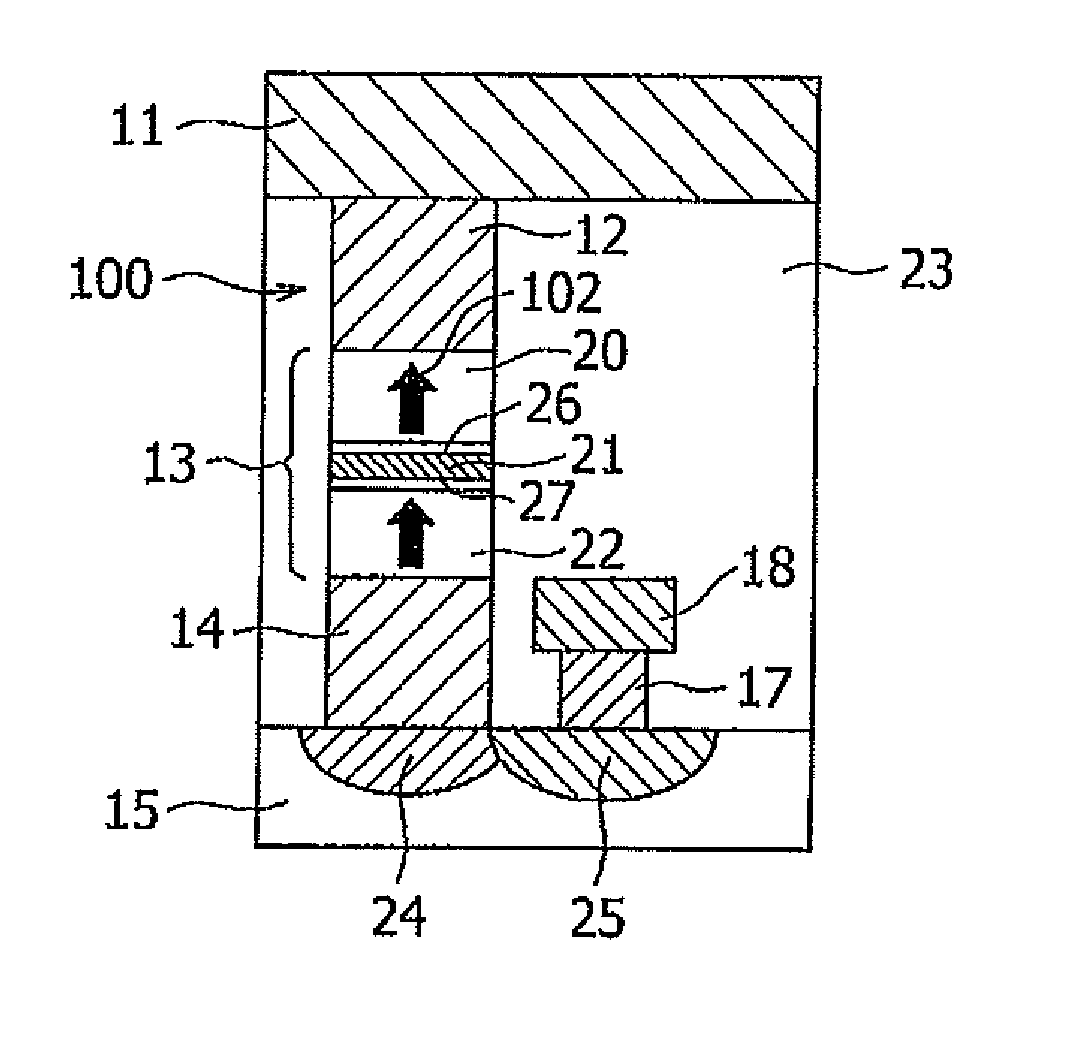Magnetoresistance element and storage device using the same
a technology of magnetic resonance element and storage device, which is applied in the direction of solid-state devices, magnetic bodies, instruments, etc., can solve the problems of large occupied area of one memory cell (the cell area), high cost, and difficult microminiaturization of cells themselves, and achieves high density, high number of rewrite cycles, and fast operation
- Summary
- Abstract
- Description
- Claims
- Application Information
AI Technical Summary
Benefits of technology
Problems solved by technology
Method used
Image
Examples
first embodiment
[0055]In a first embodiment of the invention, the structure of a memory element and principle of write operation in the embodiment of the invention are explained based on FIG. 1 to FIG. 3, and a method of manufacture thereof and technical advantageous results are explained.
[0056]Structure of Magnetic Memory Element
[0057]FIG. 1 is an enlarged cross-sectional view showing a portion of the magnetic memory element 100 of a storage device 10 comprising the magnetic memory element. The magnetic memory element 100 has a magnetic tunnel junction (MTJ) portion 13; this MTJ portion 13 is sandwiched between a lower electrode 14 and an upper electrode 12. The MTJ portion 13 has a structure in which are stacked, in order from the side of the lower electrode 14, a pinned layer 22 (first magnetic layer), first spin polarization enhancement layer 27 (third magnetic layer), insulating layer 21, second spin polarization enhancement layer 26 (fourth magnetic layer), and recording layer 20 (second magn...
second embodiment
[0079]A second embodiment of the invention is explained. The second embodiment is an embodiment in which, in the first embodiment, TbCo is used in the pinned layer. TbCo has oxidation resistance superior to that of TbFeCo, and if the magnetic memory element of this embodiment is used in a storage device, the lifetime of the storage device can be lengthened. Further, the magnetization of TbCo is lower than that of TbFeCo, so that the shape anisotropy energy is reduced, and an increase in the perpendicular-direction magnetic anisotropy energy Ku can be expected. An increase in the perpendicular magnetic anisotropy energy Ku leads to improved thermal stability. When thermal stability of the pinned layer is low, the magnetization direction is disordered upon excessive heating of the magnetic memory element, and the magnetic memory element no longer operates normally. Hence by improving thermal stability using TbCo in the pinned layer, the reliability of the storage device can be improve...
third embodiment
[0081]A third embodiment of the invention is explained. The third embodiment is an embodiment in which TbCo is used as the recording layer in the first embodiment or the second embodiment. TbCo has a magnetic anisotropy energy an order of magnitude greater than that of GdCo, and so by using TbCo in the recording layer, stored data retention characteristics can be improved. In the prior art, if the magnetic anisotropy energy of the recording layer is increased, there is the problem that the write current increases; but in this embodiment the temperature of the recording layer during writing approaches the magnetic compensation temperature, and the magnetization becomes extremely low, so that increases in the write current are suppressed and this problem is alleviated.
[0082]As the TbCo of the recording layer in this embodiment, it is preferable that the Tb composition ratio be in the range 22 to 26 at. %. Similarly to the case of the first embodiment, this is because the magnetic comp...
PUM
 Login to View More
Login to View More Abstract
Description
Claims
Application Information
 Login to View More
Login to View More - R&D
- Intellectual Property
- Life Sciences
- Materials
- Tech Scout
- Unparalleled Data Quality
- Higher Quality Content
- 60% Fewer Hallucinations
Browse by: Latest US Patents, China's latest patents, Technical Efficacy Thesaurus, Application Domain, Technology Topic, Popular Technical Reports.
© 2025 PatSnap. All rights reserved.Legal|Privacy policy|Modern Slavery Act Transparency Statement|Sitemap|About US| Contact US: help@patsnap.com



